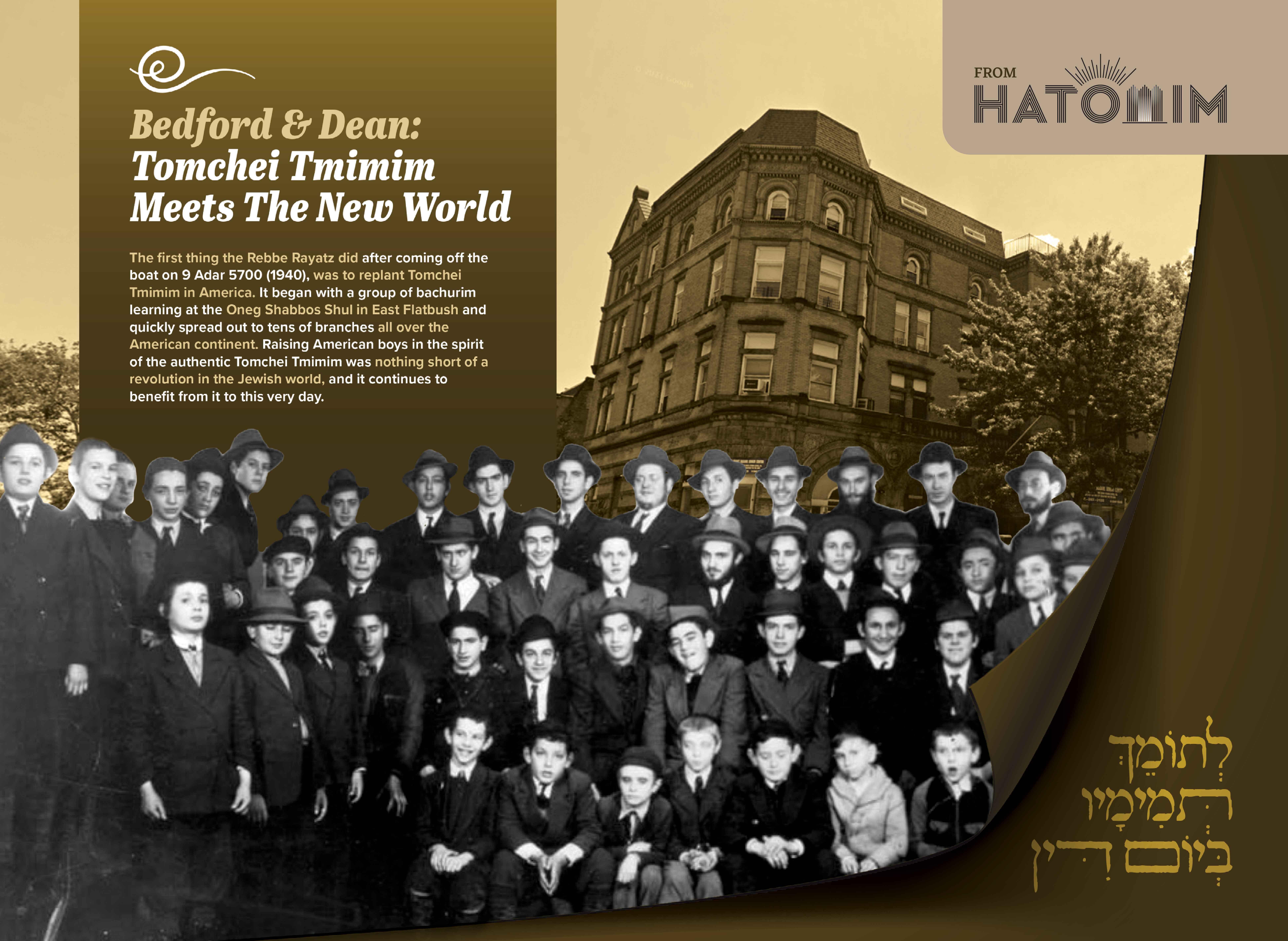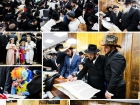Bedford & Dean: Tomchei Tmimim Meets The New World
The first thing the Rebbe Rayatz did after coming off the boat on 9 Adar 5700 (1940), was to replant Tomchei Tmimim in America. It began with a group of bachurim learning at the Oneg Shabbos Shul in East Flatbush and quickly spread out to tens of branches all over the American continent. Raising American boys in the spirit of the authentic Tomchei Tmimim was nothing short of a revolution in the Jewish world, and it continues to benefit from it to this very day • Full Article
By Hatomim Magazine
The Drottingholm blew a long blast of its whistle and slowly entered pier 97 on West 57 in New York on 9 Adar, 5700/1940. A gangplank was soon placed and the Rebbe Rayatz debarked along with his family, all survivors of the Holocaust.
The Rebbe and those with him were exhausted and broken. They had escaped with not much more than the clothes on their backs. Most of their valuable belongings and the huge library, pride of Lubavitch, had been left behind in Eastern Europe.
After a festive reception attended by thousands, the Rebbe arrived at the Greystone hotel. At a smaller reception at the hotel the Rebbe surprised those present when he dropped this bombshell: I have the pleasure of announcing a decision that was made at a special meeting of unique individuals of Anash a few hours ago, that at the Oneg Shabbos shul, yeshivas Tomchei Tmimim Lubavitch of America will open tomorrow!
The Rebbe made it clear that he wasn’t operating under any illusions. Though he had come to modern America where nearly everybody removed their beard, he had brought with him the authentic image of Eastern European Jewry. The Rebbe did not suffice with this pronouncement but asked people for their assistance:
I hope to Hashem that the rabbanim, geonim, mosdos Torah and supporters of Torah with fear of Heaven, together with my friends Anash at their head, will come to my aid in perpetuating my work in spreading Torah and fear of Heaven and in communal work.
Apparently the Rebbe’s devotees did not feel the same determination and courage as he did. They did not want him to live under the illusion that his dreams were realistic and they did not want him to be made a fool of, and so they tried to cool his enthusiasm as the Rebbe himself described in his diary (printed in Likkutei Dibburim):
Two distinguished people came to me, long-time American citizens, from the best of my devoted and loyal friends and they said to me, “We heard what you said at the reception and we attended the founding meeting of yeshivas Tomchei Tmimim Lubavitch in America, but unfortunately we must tell you about the pathetic spiritual state of America. We are saddened to tell you that your great hopes of spreading Torah and fear of Heaven and kosher Jewish education as you imagine it from the Jewish home in Europe is not at all realistic in America, despite the greatest efforts.
“We must save you from a catastrophic state and embarrassing failure and protect the honor of your great ancestors, the holy Rebbeim, may their merit protect us.”



Talmidim of Achei Tmimim in the 1930’s. From right to left: Dovber Baumgarten, Avrohom Dov Hecht, Yitzchok Ebert, Yitzchok Greenberg, Yitzchok Dovid Groner, Aryeh Leib Ebert, Berel Levy
The two of them explained the American mentality:
“America is a land that consumes the great and worthy; it consumes the greatest of the great who just arrived here and within a short time turns him, without any mercy, into the smallest of the small. America is a land of fleeting fanatical enthusiasm which ends in coldness and indifference. It has happened dozens of times before that a very enthusiastic reception in which gedolei Yisrael were honored, immediately sank into the American coldness and those honorable gedolei Yisrael were forgotten and abandoned as though they were outside the camp.
“… We are telling you only a small portion of what we need to say. We want you to have a clear picture of the situation so you will know how to deal with your mission – the work of askanus in America.”
The Rebbe was single-minded in his ideas but that doesn’t mean that he was indifferent to these warnings. On the contrary, they shook him up:
It is unnecessary to describe how I felt when I heard this from my most loyal and beloved followers and the tears that fell from my eyes when I recited my first Shema in America …
One week after the Rebbe set foot in America, the first Chassidic yeshiva was founded. On 15 Adar II, Shushan Purim, about twenty bachurim gathered in the Oneg Shabbos shul in East Flatbush in Brooklyn and started yeshivas Tomchei Tmimim Lubavitch in America.
The combination of those words “Tomchei Tmimim” and “America” was absolutely incongruous, but the Rebbe put them together, both in word and in deed.
On that same historic day when the yeshiva opened, the Rebbe addressed the bachurim and set forth the principle policy rules:
Not only will the talmidim of Tomchei Tmimim raise up, with Hashem’s help, the glory of Torah in the United States and Canada but it will also set the tone for the religious yeshivos that already exist …
My children, you ought to be happy that you have merited the great zechus to be talmidim in the holy yeshiva of Tomchei Tmimim Lubavitch. May Hashem bless you, and the friends who will join you in the future, that it should be fulfilled in all of you the wishes of our holy leader that all who see them will recognize them as blessed seed of G-d (Sefer HaSichos 5700).
“THEY WILL LEARN IN MY YESHIVOS”
If you want to understand how impossible founding Chassidic yeshivos in the spirit of Lubavitch was in America of those days, read the following:
When the Rebbe Rayatz visited the United States in 1930, the idea had already been proposed to start a Chabad yeshiva in New York, where a few Lubavitch Chassidim lived at that time. However, the spiritual climate at the time was such that even the Rebbe Rayatz concluded that the time was not right for a yeshiva that required its students to attain spiritual heights of holiness and purity. But the Rebbe knew that the day would yet come.
When the Rebbe returned to Europe, R’ Yochanan Gordon had yechidus with him, around Rosh Hashana 5691/1930. The Rebbe told him that he heard from R’ Gordon’s brothers who lived in the US that they wanted their brother to come to America too, but he refused. R’ Yochanan affirmed this and said, “I am apprehensive because of the children. My brothers’ children were corrupted and left the derech and I don’t want my children to be corrupted.”
The Rebbe said, “Go to America and I promise you that your children will remain erliche Yidden.” R’ Yochanan was still not convinced and he said that he wanted them to learn in the Rebbe’s yeshivos. The Rebbe said prophetically, “I promise you that they will learn in my yeshivos.”
R’ Yochanan’s son, R’ Sholom Dovber, later said that when his father returned home he was shaken up by the Rebbe’s promise. “To promise that they will remain erliche Yidden is one thing; that is unusual, but even in America there can be an exception to the rule. But what does it mean that they will learn in the Rebbe’s yeshivos? How can we dream about something like that in America?”
R’ Yochanan waited years for the fulfillment of his big dream. When the Rebbe Rayatz arrived in America and his children began learning in the newly founded American branch of yeshivas Tomchei Tmimim, the Rebbe’s prophecy was fulfilled.



Former site of Tomchei Tmimim in New York (Bedford and Dean)
THE YESHIVA WILL BE A BASTION OF TORAH
In the years prior to the Rebbe’s arrival, Achei Tmimim had been founded and was being run by Rabbi Yisroel Jacobson. It offered shiurim for a group of yeshiva bachurim a few times a week. In Elul, 1939, six of these bachurim left America to go and learn in the presence of the Rebbe Rayatz. The advent of World War II curtailed their stay, and they returned home not long after they had come.
At the beginning of Shevat, 5700, the Rebbe suggested that Achei Tmimim be transformed into yeshivas Tomchei Tmimim but this plan was not implemented.
When the Rebbe arrived in the US, his first mission was to found Tomchei Tmimim in New York. His health was poor, as was his financial state, but this did not deter him from going on the offensive where many gedolim before him had failed.
The Rebbe had a hard time walking and he regularly suffered from physical ailments. He also had numerous debts (as a result of his work in helping the Jews of the Soviet Union). Another person in his shoes, would seek peace and quiet after all he endured, but the Rebbe was not just another penniless refugee and he devoted himself to his work. He did not even allow himself one day of rest.
The yeshiva officially opened a week after he arrived. His son-in-law, Rabbi Shmaryahu Gurary (Rashag), was appointed the acting director of the yeshiva. Rabbi Shmuel Levitin and Rabbi Yisroel Jacobson were appointed menahalim and mashpiim, and Rabbi Mordechai Mentlick the rosh yeshiva. Rabbi Shneur Zalman Gurary was appointed in charge of the Achei Tmimim division for youth.
The 770 building was purchased at the end of 5700 and with the encouragement of the Rebbe, the yeshiva moved (at the end of Cheshvan 5701) into the building.
Yeshivas Tomchei Tmimim and its divisions were under the supervision of the Rebbe Rayatz, at first as “director of operations” and then as president. The Rebbe made no concessions and wanted the authentic spirit of Lubavitch to permeate the American yeshiva just as it did in Otvotsk, Rostov and Lubavitch. He invested great efforts to preserve the spirit of Lubavitch and the spirit of learning in the yeshiva. He constantly guided the hanhala of the yeshiva on topics of chinuch and wanted to be informed in detail about the conduct of each talmid, not only when they learned but in their free time as well. He wrote many letters on these topics, some of which are printed in his Igros Kodesh.
In the months to come, additional students joined the yeshiva, which had acquired a good reputation. In HaPardes dated Shevat, 1941, there was an article about the yeshiva’s successes:
This mosad immediately struck roots and began to grow and thrive, with Hashem’s help, and attracted excellent talmidim, gedolei Torah and yirah who diligently study Torah. The number of talmidim is growing, thank G-d, and in the future this mosad will be, with Hashem’s help, a magnificent edifice, a bastion of Torah for pride and glory, with which we can be consoled for the famous yeshivas Tomchei Tmimim Lubavitch which, due to our many sins, collapsed in the storm of war in Europe.
HOLOCAUST SURVIVORS START A YESHIVA
On 2 Cheshvan, 5702/1941, nine bachurim from yeshivas Tomchei Tmimim in Otvotsk set foot on Canadian soil. They had spent a period of time in Shanghai and after much effort on the part of the Rebbe Rayatz, they managed to make it to Canada. The Rebbe did not allow them to rest from their ordeals but immediately told them to open Tomchei Tmimim. The very next day, the new yeshiva opened in the Nusach Ari shul. Rabbi Yitzchok Hendel a”h was appointed menahel.
The Rebbe Rayatz didn’t delay and a week later he sent them a long letter with instructions about how to interact with the townspeople, as well as specific instructions regarding the talmidim of the new yeshiva: to review maamarei Chassidus on Shabbos in the two Chabad shuls in Montreal, for the tmimim to eat the Shabbos meals together, during the meal to sing Chabad niggunim after the bachurim review Chassidus, and to tell Chassidishe stories.
The tmimim enthusiastically went about fulfilling the Rebbe’s instructions. They made much publicity amongst the townspeople and recruited a number of talmidim in the shuls. In the weeks to come, the mashpia R’ Shmuel Levitin was sent to help establish the new yeshiva. In less than a month, the nine bachurim had enrolled 24 young talmidim, for whom they set up two classes of a yeshiva called Achei Tmimim.
The Rebbe Rayatz was not satisfied with this, and about a week later he sent a letter to R’ Levitin in which he complained about only having 24 talmidim. He gave practical ideas on how to recruit more students. Even after R’ Levitin returned to New York they continued expanding the yeshiva on their own.
The yeshiva grew and, for lack of other options, it was located in the local orphanage where they were given a few rooms. The Rebbe simultaneously began asking Anash and askanim in Montreal to buy a building for the yeshiva. The Rebbe sent letters to askanim who helped the yeshiva a lot and told them not to be concerned about their money but to see to it that the yeshiva got a suitable building and Hashem would repay them.
In the middle of the summer of that year they were able to buy a big building for the yeshiva. In honor of the Chanukas HaBayis that took place on 15 Kislev, 5704, the Rebbe sent a letter to the talmidim of the yeshiva in which he blessed them and the kehilla at large, led by the rabbanim, on the occasion of purchasing the building with blessings of mazal tov.
A very formal celebration took place with the participation of the rabbanim of the city and guest rabbis led by Rashag, the Rebbe’s son-in-law and acting menahel, who traveled to Montreal for the occasion.
To conclude this chapter, let us look at a letter the Rebbe wrote in which he showers unusual praise on the talmidim who started the yeshiva in Montreal:
With Hashem’s help, with your mesirus nefesh, with enormous effort and sweat, you have established, thank G-d, the yeshiva in Montreal which was – like other cities – dry of all moisture of Torah and without etc. etc. and with Hashem’s kindness the talmidim ha’tmimim were able to build a tower of Torah and light on the garbage heaps of Montreal. (Igros Kodesh Admor Rayatz, vol. 7, p 383)
In the years that followed, the yeshiva grew and it exists till today. It is considered one of the flagship Tomchei Tmimim yeshivos, a yeshiva that began with nine bachurim who escaped Europe and arrived with little besides the clothes on their backs.



Talmidei Tomchei Tmimim in 770 in the early years
A NETWORK OF YESHIVOS
It’s amazing to see how over the course of a few years the Rebbe managed, in his poor health and with little resources, to create “something out of nothing,” a network of Chassidic yeshivos throughout the United States.
Ask any menahel with modern means to make connections and reach donors and he will tell you that it is still hard to establish and run just one yeshiva. Yet, the Rebbe, with the meager means at his disposal, attained spectacular achievements during the one decade he lived in America.
From 5702 until 5705 (see box), a network of yeshivos was formed for older boys, younger boys and children. They were under the administration of the Central Yeshivos Tomchei Tmimim, with the expenses for founding and maintaining these yeshivos coming from the central organization overseen by the Rebbe Rayatz.
The list of cities with yeshivos Achei Tmimim is staggering: Pittsburgh, Newark, Worcester, Buffalo, Rochester, Boston, Philadelphia, New Haven, Bridgeport, Chicago, Bronx, Springfield and Providence.
The Agudas HaRabbanim of the United States and Canada wrote the following in Kislev, 5704:
“ … It is unbelievable and yet a happy fact, that in such a short time, so many yeshivos have been made in the following cities: Yeshiva Gedola in Montreal, Pittsburgh, Newark, Worcester, and Buffalo. Likewise, chadrei Torah were founded in various locations in Brooklyn. In all these mosdos Torah over 1000 Jewish children imbibe from the source of Torah under the influence of Torah and yiras shomayim.
“The number of talmidim is so large that the present building of the central yeshiva in Brooklyn is too small to contain them all.”
The Rebbe Rayatz wasn’t satisfied with what he had accomplished and while taking care of the yeshivos he had founded he also sought to start additional yeshivos in other cities. Even when there were failures, the Rebbe did not give up. He sent letters and emissaries, contacted local askanim and rabbanim, until he successfully established a broad network of yeshivos.
The Rebbe did not only take care of obtaining funds but was involved with every single detail and toiled mightily to best serve the talmidim. He kept tabs on every talmid’s spiritual state in avodas Hashem, Chassidus and Nigleh, as well as gashmius matters. Throughout the years, the Rebbe encouraged those who founded each yeshiva and urged wealthy people to contribute and the askanim to do their work.
Many of the menahalim of the yeshivos were talmidim of the central yeshiva in New York. For various reasons it became necessary, from time to time, to change menahalim; some of them had to return to yeshiva, others married, and some had become experienced and were assigned the task of opening a new yeshiva while their less experienced peers filled their place. This was all done by the Rebbe’s instruction.
Rashag worked extremely hard alongside the Rebbe in the role of “Menahel Merkaz Yeshivos Tomchei Tmimim.” Rabbi Chaim Mordechai Isaac Chodakov, the Rebbe’s secretary, was an outstanding educator and he kept in touch with a number of the menahalim and guided them in chinuch and other areas.
From time to time, emissaries of the Rebbe went on long trips in order to strengthen the yeshivos. Notable among them were Rabbi Shmuel Levitin and Rabbi Eliyahu Yochil Simpson.
ATTENDING EVENTS DESPITE THE HARDSHIP THIS ENTAILED
The Rebbe did not only send letters. Despite his very poor health and being unable to walk, he attended events and dinners in honor of the yeshiva. At every event he delivered a long address in which he asked the participants to take part in the heavy burden of financing the yeshiva.
(Remember that at the same time, the Rebbe was also fundraising to save Jews in Eastern Europe and to establish mosdos Chabad in other parts of the world. His debt load was enormous.)
AMERICAN RABBONIM GET INVOLVED
While Chabad yeshivos were founded outside of New York, the central yeshiva in New York continued to flourish. Hundreds of bachurim learned there and the yeshiva was reminiscent of the glory days of the yeshiva in Lubavitch. It became necessary to purchase a building for the large number of students. The Rebbe Rayatz was involved in all the discussions concerning buying a building and wrote a number of letters on the subject to Anash and askanim.
The efforts towards this end that began at the beginning of 5702 continued until 5704, when a large building was purchased on Bedford, a twenty minute walk from 770.
Agudas HaRabbanim of the United States and Canada and other distinguished rabbanim raised money for Tomchei Tmimim and in HaPardes it said:
… Good news for all of American Jewry – boruch Hashem a large, magnificent building was purchased in the center of Brooklyn which will allow place for additional hundreds of talmidim, may they increase. Obviously, for all these massive activities, enormous sums of money are needed. It is the obligation of every Jew, no matter what party, to help as much as possible in this holy work in the most important field in Jewish life on which depends the future of American Jewry – the education of the young generation.
The same issue included a public call by Rabbi Yisroel Rosenberg and Rabbi Eliezer Silver. R’ Silver said that he spoke in learning with talmidim in yeshivos Tomchei Tmimim and derived much pleasure from them:
“We have merited, since the arrival here of the gaon and tzaddik the Admor of Lubavitch, who founded, with Hashem’s help, in towns and cities, yeshivos large and small that are truly a glorious achievement, and will grow into mighty oaks. I got to know and talk with in learning some of the gedolei ha’talmidim and found them to be full of Torah and talent, full of yiras shomayim, learning diligently, baalei middos who are filled with blessing.”
In the winter of 5706, the yeshiva with all its divisions completed its move to the new building. A number of festive events were held in honor of the chanukas ha’bayis.
INTERIM ACCOUNT
On 16 Adar, 1945, a festive event was held to mark five years since the founding of Tomchei Tmimim in New York. The Rebbe Rayatz personally attended and he told about the founding of the yeshiva and those who tried to discourage him:
“Over the course of three years, boruch Hashem, the American spiritual sea of ice broke and my earlier proclamations about spreading Torah with yiras shomayim and proper chinuch, teshuva and Geula, which over the years were attacked and mocked by the left, center and the right, are now being heard from time to time from a few of those who have ambitions as leaders of the generation.Another year goes by and in the newspapers articles are published and events are planned to start special funds to spread Torah and for chinuch …
Another year passes and boruch Hashem, my assistants in the field of spreading Torah and yiras shomayim, led by my son-in-law Rabbi Gurary, have already founded dozens of mosdos Torah and yiras shomayim, and my assistants in the field of proper chinuch and Machne Israel led by my son-in-law, Rabbi Schneersohn [the Rebbe MH”M who ran Merkos L’Inyonei Chinuch and Machne Israel] started schools for girls and over half a million copies of publications have already appeared…
American Jewry! In five years the work of Merkaz “Tomchei Tmimim Lubavitch” in America has established Jewish respect in this country and clearly proved that American children can be bnei Torah like in the alte heim.
American Jewry! Our call – of the Central Tomchei Tmimim Lubavitch in America – is to make America, with Hashem’s help, be a place of Torah so that on a Jewish street in America the sound of Torah will be heard from young children as it was heard in Lubavitch and in other cities in Lithuania and Poland.
Five years later, marking ten years since the founding of yeshivas Tomchei Tmimim in New York, was reason for another gala event. The hanhala of the yeshiva planned a resplendent event for this significant milestone.
The Rebbe wrote a special letter for the dinner with a call to attend it and with the goal of doubling and tripling the donations for the yeshiva.
Erev Shabbos, 9 Shevat afternoon, the Rebbe signed the letter and the next day he was nistalek. This was the last letter the Rebbe signed.
After the histalkus the question was whether to hold the dinner on the designated date. It was finally decided not to postpone it since the Rebbe himself had told people to attend the dinner. However, the dinner was held without music and the great simcha originally planned, but a large crowd attended it as well as the talmidim of the yeshiva. The speakers made a powerful impression on the donors, who responded more generously than usual.
Thus the Rebbe Rayatz completed his earthly mission as an integral part of yeshivas Tomchei Tmimim, for which he worked for nearly 53 years – from his marriage in 5657/1897 when he was 17, until his final day.
Sources: Likkutei Dibburim, Sifrei HaSichos of the Rebbe Rayatz, Igros Kodesh of the Rebbe Rayatz, Toldos Chabad in America, Zikaron L’B’nei Yisroel, Yemei Bereishis, Beis Moshiach, HaTomim (a Beis Moshiach supplement), the website – “Shalom iz mainer”
THE NETWORK OF YESHIVOS FOUNDED IN FIVE YEARS!
The rate at which yeshivos were founded in America is astonishing:
15 Adar II, 5700 – New York – the Rebbe Rayatz, upon his arrival in New York, opened yeshivas Tomchei Tmimim
3 Cheshvan, 5702 – Montreal – Nine talmidim from Tomchei Tmimim in Otvotsk, who escaped to Shanghai and arrived in Canada, opened yeshivas Tomchei Tmimim.
Kislev, 5702 – Pittsburgh – the yeshiva was started by Rabbi Mordechai Altein. He arrived in Kislev and after much effort, the yeshiva opened before Pesach. Already in the first few months, 60 talmidim learned there. At the end of the summer of 1943, Rabbi Sholom Posner was appointed the menahel of the yeshiva which he ran, devotedly, for decades.
Sivan, 5702 – Newark – Rabbi Sholom Dovber Gordon ran the yeshiva. Rabbi Dovid Stockhammer and his sons-in-law, Rabbi Mordechai Mentlick and Rabbi Moshe Pinchas Katz helped.
12 Tammuz, 5702 – Worcester – the yeshiva was founded on the Chag HaGeula, 12 Tammuz, 1942. Before it opened, the designated menahel, Rabbi Avrohom Dov Hecht arrived accompanied by Rabbi Avrohom Pariz.
Buffalo – R’ Fogelman founded and ran this yeshiva at first. On 23 Av there was a founders meeting. A few months went by and the number of talmidim grew and the yeshiva moved into a new building. Rabbi Fogelman later on took over the yeshiva in Worcester.
Cheshvan, 5704 – Rochester –directed by Rabbi Tzvi Shusterman.
13 Shevat, 5704 – Boston – In Adar, 1943, an attempt was made to start a yeshiva in Boston but it soon closed. The yeshiva re-opened and was run by R’ Avrohom Dov Hecht. By the winter of 5705 the yeshiva already had 80 students.
2 Iyar, 1944 – Philadelphia – On 2 Iyar, 1944, the yeshiva Achei Tmimim was founded in Philadelphia under R’ Yosef Menachem Mendel Tenenbaum and R’ Yitzchok Dovid Groner. R’ Sholom Tzvi Schneiderman, a distinguished Lubavitcher rav and menahel of yeshivas Ohel Moshe there, asked that his yeshiva be under the auspices of Tomchei Tmimim and his request was granted too.
Rosh Chodesh Tammuz, 1944 – New Haven – R’ Mordechai Dov Altein and his helpers, R’ Berel Levy and R’ Zev Schildkraut started the yeshiva in New Haven. The learning began with dozens of children in the Beis Yisrael shul. On the following Shabbasos most students came to shul wearing yarmulkes with the name of the new yeshiva printed on them. They attended Mesibos Shabbos and formed a parade through the streets of New Haven which called upon Jews to keep Shabbos.
14 Tammuz, 1944 – Bridgeport, the yeshiva was opened by Rabbi Elozor Pinchas Weiler and a short time later the permanent menahel, Rabbi Dovid Edelman, arrived with Rabbi Tzvi Feffer.
Elul, 5704 – Chicago – After much effort, Achei Tmimim opened in Chicago in the summer of 1944, led by Rabbi Yosef Wineberg. A group of talmidim from New York arrived with him.
18 Shevat, 5705 – Bronx – the yeshiva opened in the Nusach Ari shul on 1243 Washington Avenue. The menahel of the yeshiva was Rabbi Altein and the teacher for the oldest group of students was Rabbi Nosson Teomim. A committee of distinguished balabatim helped found and maintain the yeshiva.
Winter, 5705 – Springfield – Rabbi Sholom Dovber Gordon opened the yeshiva with ten talmidim in the home of a supporter of the yeshiva. The school operates to this very day under the able and devoted leadership of Rabbi Dovid Edelman (a’h) for more than half a century.
23 Av, 1945 – Providence – the final yeshiva founded in this period of time. The yeshiva opened on 23 Av and was led by Rabbi Yitzchok Dovid Groner with the devoted assistance of the rabbanim and brothers, Rabbi Yehoshua Werner and Rabbi Dovid Werner.
*
The magazine can be obtained in stores around Crown Heights. To purchase a subscription, please go to: bmoshiach.org.
To download the Hatomim Magazine for free, Click Here.
598
Join ChabadInfo's News Roundup and alerts for the HOTTEST Chabad news and updates!












































14 Tammuz, 1944 – Bridgeport, the yeshiva was opened by Rabbi Elozor Pinchas Weiler and a short time later the permanent menahel, Rabbi Dovid Edelman, arrived with Rabbi Tzvi Feffer.
and continued by Rabbi Yisroel Stock (chabad bartzot habris…)